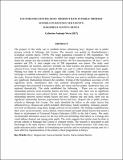Factors Influencing Boys` Dropout rate in Public Primary Schools in Matungu Sub County, Kakamega County, Kenya

View/
Date
2017Author
Were, Catherine Andanje
Type
ThesisLanguage
enMetadata
Show full item recordAbstract
The purpose of this study was to establish factors influencing boys’ dropout rate in public primary schools in Matungu Sub County. The research was guided by Bronfenbrenner`s ecological systems theory, (1979). The target population consisted of 290 respondents. The research used purposive, convenience, stratified and simple random sampling techniques to obtain the sample size that included 19 head teachers, 38 PTA representatives, 38 class 7 and 8 teachers and 195. A total sample size of 290 respondents was drawn. The study used questionnaires for teachers, interview schedule for head teachers and parents’ representatives whereas Focus Group Discussion guide (FGD) was used to collect information from pupils. Piloting was done in two schools in Lugari Sub County. The researcher used test-re-test technique to establish instrument`s reliability. Descriptive survey research design was applied by the study. Pearson Product Moment Correlation Co-efficient was used to establish existence of any significant relationships between the variables. Testing of the hypotheses was done at 0.05 significant levels. Quantitative data was analysed descriptively using frequencies and percentages then presented in frequency tables, pie charts and bar graphs. Qualitative data was analysed thematically. The study established the following: - There was no significant relationship between socio-economic factors and boys` dropout rate, there was no significant relationship between socio-cultural factors and boys` dropout rate, there was no significant relationship between school related factors and boys` dropout rate and lastly, there was no significant relationship between pupil-related factors and boys` dropout rate in public primary schools in Matungu Sub County. The study identified the follow as the major factors that influenced boys’ dropout rate which included; child labour, family instability, initiation, parents` low level of education, drug abuse, hunger and lack of role models. The findings established that there were social-economic, socio-cultural, school-related and pupil-related factors that posed a threat to achievement of Universal Primary Education (UPE) in the Sub County. The study recommended affirmative action for the boy-child and abolishing child labour as a strategy that could address dropout rate among male pupils. The study suggests that similar study be done in private schools in Matungu Sub County to compare results. The research is anticipated to add knowledge to the male learners` education that currently has limited literature. This study may guide education policy makers in formulating new policies and re-evaluating existing ones for a more effective implementation of the primary school programmes in Kenya.
Publisher
Africa Nazarene University
Collections
- Education [59]
